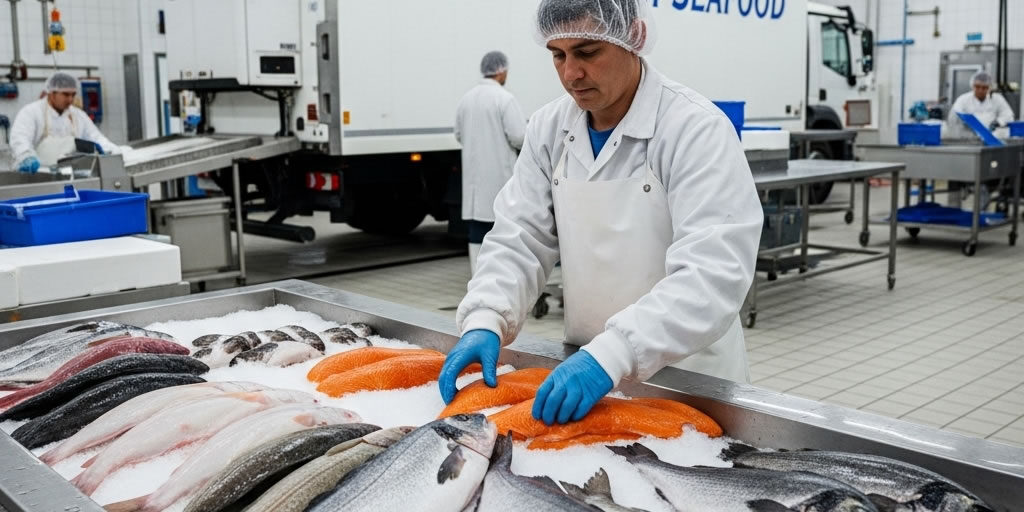- Software Gestor para Aquicultura
- (85) 2139-6730
- contato@despesca.com.br
Logistics and cold chain: ensuring your product reaches the final consumer with maximum quality

Fish Farming: How to Calculate Initial Investment and Break-Even Point
22/08/2025
Social Responsibility in Aquaculture: Strengthen Your Brand Through Local Community Engagement
26/08/2025The journey of a high-quality fish or shrimp does not end at harvest. On the contrary, a new and critical phase begins: ensuring that all the investment in genetics, nutrition, and management is reflected in the freshness and safety of the product that reaches the consumer’s table. Logistics and the rigorous maintenance of the cold chain are the links that connect the success of production to success in the market. Any failure in this process can result in significant financial losses and, more importantly, damage to brand reputation.
The Critical Importance of the Cold Chain in Aquaculture
The cold chain is a sequence of refrigeration steps, from harvesting to consumption, aimed at keeping seafood within a controlled temperature range, ideally close to 0∘C (32°F). Its importance is multifaceted. Firstly, from a food safety standpoint, low temperatures drastically inhibit the proliferation of spoilage and pathogenic microorganisms, which are the main causes of decomposition and potential foodborne illnesses.
Furthermore, temperature control is fundamental for preserving the sensory quality of the product. Characteristics such as the firm texture of the meat, the mild and characteristic odor, the vibrant color, and the delicate flavor are directly dependent on the maintenance of the cold chain. Enzymatic degradation and lipid oxidation, processes that negatively alter these attributes, are accelerated at inadequate temperatures. Consequently, a product that maintains its original characteristics has a higher market value, justifying better prices and strengthening customer loyalty.
Essential Steps: From Post-Harvest to Point of Sale
A robust cold chain requires meticulous attention at each step of the process:
- Immediate Post-Harvest: The most crucial action is the rapid cooling of the seafood immediately after its removal from the water. The use of a mixture of ice and water (preferably with flake ice, which does not cause mechanical damage) is essential to quickly reduce the body temperature of the animals, minimizing stress and the onset of the spoilage process.
- Processing: Whether in gutting, filleting, or cooking, all processing steps must occur in air-conditioned and sanitized environments, always keeping the product temperature low.
- Packaging: The choice of packaging is strategic. Isothermal materials and vacuum packaging, for example, not only protect the product against physical and microbiological contamination but also help maintain temperature and extend shelf life.
- Storage and Transportation: Cold storage and refrigerated vehicles must operate with temperature control and recording systems. It is vital that there are no temperature breaks during loading, transportation, and unloading, as each thermal variation accelerates the loss of quality.
Optimizing Logistics with Aquaculture Management Software
The complexity of logistics in modern aquaculture demands more than just good practices; it requires data management and precise control. This is where aquaculture management software like Despesca becomes an indispensable tool.
The platform allows for the integration of all production information. By recording data from each harvest — such as volume, average weight, and originating pond — the system creates traceable batches. This traceability is fundamental, as it connects information from the production cycle (feed used, treatments, water parameters) with logistics chain data.
With Despesca, the producer efficiently manages inventory control, applying the FIFO (“First In, First Out”) principle, ensuring that older batches are shipped first. Furthermore, the ability to record and analyze the costs associated with each stage of logistics — such as ice, packaging, freight, and storage — allows for more accurate pricing and the identification of opportunities for cost optimization.
In summary, investing in efficient logistics and a cold chain is not an expense but a direct investment in the quality, safety, and value enhancement of your product. The use of monitoring technologies and an integrated management platform, such as Despesca, empowers the producer to have full control over this process, ensuring that the excellence achieved within the farm is the same perceived by the final consumer.

